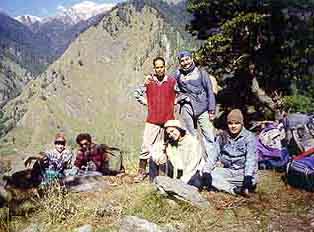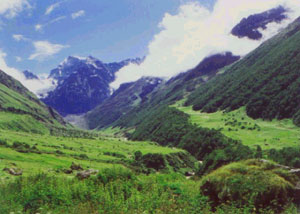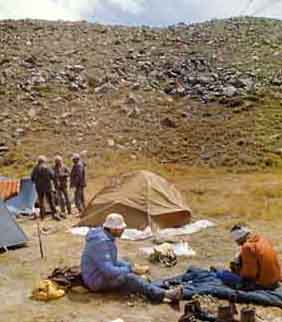This note is prepared for parents, school principals, teachers, leaders and organisers of outdoor adventure programmes specially dealing with climbing activities. It suggests what parents, school authorities and participants must understand and check before joining any outdoor programme. It also advises what organisers of such outdoor programmes must ensure to inform the participants. It is hoped that this will lead to better understanding of outdoor activities and better standards of safety in the outdoors.
for parents, school principals, teachers, leaders and organisers of outdoor adventure programmes specially dealing with climbing activities. It suggests what parents, school authorities and participants must understand and check before joining any outdoor programme. It also advises what organisers of such outdoor programmes must ensure to inform the participants. It is hoped that this will lead to better understanding of outdoor activities and better standards of safety in the outdoors.
Clarifications to be sought about the programme
1. Schedule for the programme with day to day activities to be conducted.
Check whether the program is realistic:
Duration of the trek, or camp, day to day programme, daily routine, specification of the activities whether rock-climbing, river crossing, or only trail walking. The vital information about the trek should include stages for each day, distances, and climb or descent involved. Approximate altitude of each camp. Leisure and informative activities like map-reading, rope practise, looking at flora and fauna, setting up of a camp, all these should be part of the programme. Only physical activities can be very exhausting or boring. The programme should allow sufficient time to the participant to cope with the schedule. For high attitude areas specially, sufficient time is necessary for acclimatisation.
2. In case of Himalayan treks what will be the maximum attitude reached by the group on each day? What would be the approximate height gain from the last camp site at every stage? What would be the process of acclimatisation ?
Beyond 2500 m. (8000 ft) it is advisable to gain altitude gradually. It is suggested that for every 2000 ft gain at least two days of acclimatisation period be kept. Take proper assurance that the acclimatisation period planned for by the organisers is sufficient and will be adhered to. Above 15,000 ft, "climb high and sleep lower" must be adopted to acclimatise. Plans for a hurried trip should not be accepted. Activities in a camp will also help acclimatisation.

3. What are the major difficulties expected on the program as regard the terrain, facilities or any other matter that will affect the participant.
The terrain on the Himalayan trails differ. One should have a fair idea of different terrain like simple walking trails, scree-slopes, and crossing of small nalas. Simple safety rules are to be followed at each stage, depending on the age group. Please judge whether you would like to expose yourself or children to the difficulties / risks envisaged by the organisers.
4. What is the level of fitness expected from the participants?
Trekking and camping is a sport. There is a certain level of physical fitness required for altitude trekking. Trekking and camping at low levels can be done with minimum fitness and can be very enjoyable for young children. Please remember no child will get fit in two week's time. If the child is not physically fit introduction to trekking should be with simple treks which will include only plain walking and camping. One must relate the level of fitness in a child and the level of trekking he is participating in. It should be an enjoyable experience. Please judge whether the participant meets the required level of fitness before starting on the trek. Take professional advice if you feel you are unable to judge for yourself.
 5. What are the medical facilities provided by the organisers? Whether a doctor will accompany the program and / or alternative plans exist to deal with medical problems. If a doctor is accompanying the group, check out his/her qualifications.
5. What are the medical facilities provided by the organisers? Whether a doctor will accompany the program and / or alternative plans exist to deal with medical problems. If a doctor is accompanying the group, check out his/her qualifications.
Make sure you feel comfortable with the answers given to you regarding medical facilities. Take professional advise if you feel you are unable to judge for yourself. If the child is big enough to look after his own self, on a trek the child also has to be briefed how to look after sore feet, sore throat, changing of wet socks, types of clothing to use etc. Person in charge of medical facilities should be specifically trained in "Wilderness first-aid" and be aware of high attitude problems. A certificate to the effect that the volunteers / doctors are adequately trained and have the requisite experience to conduct such activities should be ensured.
6. Communication channel to be utilised by the group during activities as well as in case of emergencies.
Parent must be able to contact the group in case of an emergency and please make sure you are also available in case they need to contact you. Keep addresses, phone numbers and details of the schedule handy for any emergencies. Please obtain details of all persons who are responsible for co-ordination with you.
 7. What are the facilities provided for accommodation throughout the program?
7. What are the facilities provided for accommodation throughout the program?
Please ensure that the facilities to be provided are reasonable. This includes general safety of the camp location as well as hygienic camp-sites.
8. What is the provision for water management for the program? How is water purity ensured? Does the team carry Electral / Glucose powder ?
Ensure adequate care is being taken for sufficient supply of clean and purified water throughout the program. The health of the participant depends a lot on the drinking water. Each person must consume at least 4 litres of liquid per day on a good trek.
Adequate liquid intake is the single-most important factor in preventing illness and fatigue. Organisers should understand the importance of "water management" and provide adequate supply of clean liquids: with water purifiers: like iodine and chlorine.
9. Whether adequate equipment is available with the organisers for safely conducting the program ?
The equipment required for trekking and camping will vary according to the programme. A simple trail walk will require only camping tents etc. But rock climbing will require specialised equipment which is necessary for safety of the participants. Please take professional advise if you are not able to judge for yourself.
10. What do the organisers ask the participants to bring?
The organisers must give exact lists of things to be carried by the participants. Bare minimum yet very essential things are required on a trek. For example, a torch, spoon, water bottle are essential, but a pillow or Turkish towel are not necessary. Parents should minimise the things to be sent as advised by organisers.
11. What is the age distribution of the participants? What is the size of the group? What would be the instructor to student ratio?
It is not advisable to have a very large age distribution amongst the participants since different age groups have different levels of fitness, interests, attitudes etc. A large age difference can result in difficulties of compatibility as well as health risks at attitude. For example a group of 7 to 9 years will have very different energy level than group of 12 to 15-year-olds.
Information about organisers to be obtained
1. Whether the organisation is registered with the Indian Mountaineering Foundation.
Do not deal with organisations which are not registered with the Indian Mountaineering Foundation.
2. What is the composition of the management of the organisation? Get details of the antecedents of the management.
A well established organisation, whether commercial or non-profit will always take care to ensure full safety of the participants. It is not advisable to go with temporary operators. Ensure that the organisers are responsible people.
 3. A declaration that the organisers are adequately equipped / qualified / trained / experienced to conduct the activity and the volunteers will take adequate safety measures during the program.
3. A declaration that the organisers are adequately equipped / qualified / trained / experienced to conduct the activity and the volunteers will take adequate safety measures during the program.
You must however be aware that any outdoor activity involves an inherent risk. Even in the best organised program, an accident can take place beyond the reasonable control of the organisers.
4. Bio-data / experience of the Group Leader / Program Director in charge of the group. In what manner is he / she experienced / qualified to conduct the program? Who are the High Attitude Supporters and camp helpers (porters, sherpas, cooks ) employed by them ?
The person in charge should have sufficient experience in handling groups in the outdoors. In case of children, it is necessary that the person is able to deal with them specially, since children need special care in the mountains. The qualifications / experience should match the requirements of the program.
5. Ask for at least five references of participants who have been on a program under the leadership / directorship / management of the person in charge accompanying the group.
Talk to all the five references and take a feedback on
1. Food , water, accommodation facilities provided.
2. Attitude / leadership and nature of the person in charge of the group.
3. Safety factors followed by the organisation.
4. Whether safety instructions given to the child are clear, so that it can be followed well.
The safety instructions are for enjoyment of the trek and not to frighten any one.
The rules of walking and climbing teach an individual to live and enjoy nature, it also teaches endurance in day to day life without city comforts. An outdoor experience should not be a torturous affair, but a pleasant experience.
6. Have a meeting with the organisers and meet the group leader. Question how he / she is going to go about taking care of the participants with respect to the above mentioned factors.
Ensure you are fully satisfied in all respects. If unsure, do not hesitate to express your doubts. If you are still not fully satisfied, do not get pressurised to join the program.
7. If possible request for a slide show / video clip of the place to be visited.
Though this is not absolutely necessary and many times not possible, but this will give you a good idea of what you are going in for. If you are visiting an area you have not visited before, it would be a good idea to read information about the place. A sketch map of the area should be given to each participant. Ask the organisers to provide you information about the place. Expected climatic conditions of the region should be known.
8. Obtain a declaration that the participant has been examined by the organisers and is found medically fit to undergo the training / activity.
This should be in addition to your independent examination from your own doctor.
9. Inquire whether adequate insurance including rescue insurance has been taken.
Adequate insurance should be taken to cover the lives of the organisers, participants as well as staff hired by the organisers. Adequate rescue insurance will ensure that even if air rescue is necessary, the organisers will not hesitate to opt for it.
 for parents, school principals, teachers, leaders and organisers of outdoor adventure programmes specially dealing with climbing activities. It suggests what parents, school authorities and participants must understand and check before joining any outdoor programme. It also advises what organisers of such outdoor programmes must ensure to inform the participants. It is hoped that this will lead to better understanding of outdoor activities and better standards of safety in the outdoors.
for parents, school principals, teachers, leaders and organisers of outdoor adventure programmes specially dealing with climbing activities. It suggests what parents, school authorities and participants must understand and check before joining any outdoor programme. It also advises what organisers of such outdoor programmes must ensure to inform the participants. It is hoped that this will lead to better understanding of outdoor activities and better standards of safety in the outdoors.

 5. What are the medical facilities provided by the organisers? Whether a doctor will accompany the program and / or alternative plans exist to deal with medical problems. If a doctor is accompanying the group, check out his/her qualifications.
5. What are the medical facilities provided by the organisers? Whether a doctor will accompany the program and / or alternative plans exist to deal with medical problems. If a doctor is accompanying the group, check out his/her qualifications. 7. What are the facilities provided for accommodation throughout the program?
7. What are the facilities provided for accommodation throughout the program?  3. A declaration that the organisers are adequately equipped / qualified / trained / experienced to conduct the activity and the volunteers will take adequate safety measures during the program.
3. A declaration that the organisers are adequately equipped / qualified / trained / experienced to conduct the activity and the volunteers will take adequate safety measures during the program.